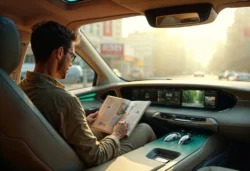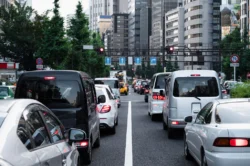The rise of robotaxis – autonomous vehicles revolutionizing urban transportation—has sparked a transformative shift, challenging the traditional taxi industry that has long defined city mobility. As of 2025, companies like Tesla, Waymo, and Baidu’s Apollo Go are deploying self-driving fleets in cities like Austin, San Francisco, and Wuhan, offering lower fares, advanced safety features, and eco-friendly travel. Powered by AI, sensors, and cameras, robotaxis promise to redefine the passenger experience, but their rapid adoption raises questions about their impact on safety, affordability, and the economy compared to human-driven taxis.
This article explores how robotaxis stack up against traditional taxis, focusing on their unique features for travelers, the safety standards that govern them, and their broader implications for governments and economies. While robotaxis aim to reduce accidents and emissions, they face technical challenges and concerns about displacing drivers. Traditional taxis, valued for their human touch and widespread availability, grapple with higher costs and human error. By analyzing recent data and real-world trends, we aim to provide a clear comparison of these transportation modes and their role in shaping the future of urban mobility.
1. Unique Features for Travelers
Robotaxis
Robotaxis, operating at SAE automation levels 4 or 5, provide a fully autonomous experience, eliminating the need for a human driver. This offers several advantages for travelers:
- Cost-Effectiveness: By removing driver salaries and benefits, robotaxis can significantly reduce fares. For example, in Wuhan, China, a 10-kilometer ride in a Baidu Apollo Go robotaxi costs between 4 and 16 yuan ($0.60 to $2.30), compared to 18 to 30 yuan for a traditional taxi. In the U.S., Waymo’s fares have reached parity with Uber and Lyft, averaging around $22 per ride by late 2024.
- Consistent Service Quality: Operated by a single company, robotaxis maintain uniform standards for vehicle cleanliness, maintenance, and operational procedures, ensuring a predictable experience.
- Enhanced Accessibility: Robotaxis can be designed with features like automatic doors and ramps, making them more accessible for people with disabilities. This contrasts with traditional taxis, which may not always accommodate such needs.
- Geo-Fenced Operations: To ensure safety, robotaxis operate within predefined areas (Objective Design Domain, ODD) where their technology has been thoroughly tested. For instance, Baidu’s Apollo Go in Wuhan covers 9 million residents with 24/7 service.
- Productive Ride Time: Without a driver, passengers can use their travel time for work, relaxation, or other activities, enhancing convenience.
Traditional Taxis
Traditional taxis, driven by human operators, remain a staple of urban transportation, offering distinct features:
- Human Interaction: Drivers can assist with directions, luggage, or provide local insights, which some travelers find valuable. This personal touch can enhance the experience for those who prefer social engagement.
- Flexibility: Traditional taxis can be hailed on the street or booked via apps, offering immediate availability in most urban areas. Unlike robotaxis, they are not restricted to geo-fenced zones, making them versatile in regions where autonomous vehicles are not yet operational.
- Widespread Availability: Available in nearly every city worldwide, traditional taxis are a reliable option, especially in areas where robotaxi services are still in early stages.
Comparison Table
| Feature | Robotaxi | Traditional Taxi |
|---|---|---|
| Operation | Fully autonomous (SAE Level 4/5) | Human-driven |
| Cost | Lower fares (e.g., $0.60-$2.30 for 10 km in China) | Higher fares (e.g., $2.50-$4.30 for 10 km in China) |
| Service Consistency | Uniform standards set by company | Varies by driver and company |
| Accessibility | Designed for accessibility (e.g., automatic doors) | Limited accessibility features |
| Availability | Limited to geo-fenced areas in select cities | Widely available in most cities |
| Passenger Experience | Productive ride time, no driver interaction | Human interaction, potential for local insights |
2. Safety Standards
Robotaxis
Robotaxis leverage advanced technology to enhance safety, but they face ongoing challenges:
- Advanced Safety Features: Equipped with sensors, cameras, radar, and AI, robotaxis aim to eliminate human error, a leading cause of accidents. A 2024 Waymo study reported an 85% reduction in injury crashes per mile driven compared to human-driven vehicles. Baidu’s Apollo Go has traveled over 100 million kilometers without a major accident as of 2024.
- Regulatory Oversight: Strict regulations govern robotaxi operations. In China, regulations finalized in December 2023 allow remote operators to monitor up to three vehicles, with specific accident reporting requirements. In the U.S., companies like Waymo and Tesla require permits from state authorities, such as the California Public Utilities Commission.
- Challenges and Incidents: Despite their safety potential, robotaxis have faced issues, such as blocking roads due to lost connectivity (e.g., San Francisco, 2023) or failing to yield to emergency vehicles. A notable incident involved a Cruise robotaxi dragging a pedestrian 20 feet after a collision in 2023, leading to a recall and license revocation in California. Public trust remains a hurdle, particularly after a fatal Uber test vehicle accident in 2018.
Traditional Taxis
Traditional taxis rely on human drivers and established safety protocols:
- Human Oversight: Safety depends on driver training, adherence to traffic laws, and experience. However, human error contributes to a significant portion of road accidents.
- Regulatory Standards: Drivers must pass background checks, obtain licenses, and ensure vehicles undergo regular inspections for roadworthiness. Insurance frameworks are well-established, covering both drivers and passengers in case of accidents.
- Limitations: Human error, such as distracted driving or fatigue, remains a key safety concern. Unlike robotaxis, traditional taxis lack the advanced sensor systems that can detect and respond to hazards in real time.
Safety Comparison Table
| Aspect | Robotaxi | Traditional Taxi |
|---|---|---|
| Safety Technology | Sensors, cameras, AI; 85% reduction in injury crashes (Waymo, 2024) | Relies on driver skill and basic vehicle safety features |
| Regulatory Oversight | Strict regulations (e.g., remote operators, accident reporting) | Driver licensing, vehicle inspections, insurance requirements |
| Challenges | Connectivity issues, public trust, occasional incidents | Human error (e.g., distracted driving, fatigue) |
| Accident Record | Few major incidents; one fatality (Uber, 2018) | Higher accident rates due to human error |
3. Impact on Government and Economy
Robotaxis
Robotaxis have the potential to reshape urban economies and government policies:
- Road Safety: By reducing human error, robotaxis can lower traffic accident rates, reducing healthcare costs and boosting productivity. For example, Waymo’s safety improvements could save billions in accident-related expenses.
- Urban Planning: With fewer privately owned cars, cities may require less parking space, freeing up land for parks, housing, or commercial development. This could also alleviate traffic congestion in urban centers.
- Environmental Benefits: Most robotaxis, such as Tesla’s Cybercab, are electric, contributing to reduced emissions and supporting sustainability goals. This aligns with government initiatives to combat climate change.
- Economic Opportunities: The robotaxi industry creates jobs in technology, engineering, and data analysis. The global robotaxi market is projected to grow from $1.76 billion in 2022 to $98.59 billion by 2030, with a CAGR of 65.3%. Companies like Baidu aim for operational breakeven, indicating economic viability.
- Job Displacement Concerns: The rapid adoption of robotaxis, particularly in China, has raised concerns about job losses for traditional taxi drivers. In Wuhan, the expansion of Baidu’s Apollo Go has sparked protests among gig economy workers.
- Regulatory Challenges: Governments must develop new frameworks to regulate autonomous vehicles, balancing safety with innovation. For example, China’s 2023 regulations and U.S. state permits demonstrate proactive oversight.
Traditional Taxis
Traditional taxis remain a vital part of the economy but face challenges from automation:
- Employment: Traditional taxis provide livelihoods for millions of drivers worldwide, supporting the gig economy. In cities like New York and London, taxi drivers are a significant workforce.
- Tax Revenue: Licensing fees, taxes on fares, and vehicle-related taxes generate substantial government revenue. For example, taxi medallions in major cities contribute millions annually.
- Traffic Congestion: High numbers of taxis can exacerbate urban traffic, particularly in densely populated areas. However, cities are mitigating this through policies like congestion pricing.
- Emissions: Traditional taxis, especially those using fossil fuels, contribute to air pollution. However, many cities are transitioning to electric or hybrid taxi fleets to align with environmental goals, such as London’s Ultra Low Emission Zone (ULEZ).
Economic Impact Comparison Table
| Aspect | Robotaxi | Traditional Taxi |
|---|---|---|
| Road Safety | Reduces accidents, lowers healthcare costs | Higher accident rates due to human error |
| Urban Planning | Reduces parking needs, eases congestion | Contributes to congestion in busy cities |
| Environmental Impact | Electric vehicles reduce emissions | Mixed; transitioning to electric/hybrid fleets |
| Employment | Creates tech jobs, displaces drivers | Supports millions of driver jobs |
| Economic Growth | Market projected to reach $98.59B by 2030 | Generates tax revenue, supports automotive industry |
| Regulatory Needs | Requires new frameworks for autonomy | Established licensing and insurance systems |
4. Conclusion
Robotaxis and traditional taxis represent two distinct approaches to urban mobility, each with unique strengths and challenges. Robotaxis offer cost-effective, safe, and accessible transportation, with the potential to transform cities by reducing accidents, emissions, and parking needs. However, they face technical hurdles, public trust issues, and concerns about job displacement. Traditional taxis provide human interaction, flexibility, and widespread availability, but they are more susceptible to human error and higher operational costs.
As of 2025, robotaxis are gaining traction in cities like Austin, San Francisco, and Wuhan, driven by companies like Tesla, Waymo, and Baidu. Traditional taxis, while still dominant, face increasing competition from autonomous vehicles. The future of urban mobility will likely involve a hybrid model, with robotaxis and traditional taxis coexisting as governments and companies navigate the transition. Balancing innovation with social and economic considerations will be key to ensuring a sustainable and equitable transportation ecosystem.







